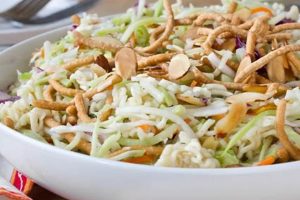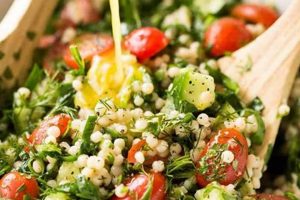This classic layered salad typically features a base of iceberg lettuce, followed by layers of peas, shredded carrots, chopped tomatoes, crumbled bacon, crumbled hard-boiled eggs, and a topping of grated cheddar cheese. Variations may include other ingredients like green onions, black olives, or different cheeses. A creamy dressing, often mayonnaise-based, is usually served separately or spread over the topmost layer.
Its popularity stems from its ease of preparation, visually appealing presentation, and customizable nature. The layered construction allows for individual flavors to shine while also creating a harmonious blend when combined. A staple at potlucks and picnics for generations, this dish embodies a practical approach to entertaining, offering a refreshing and satisfying salad option that can be prepared in advance. This make-ahead quality contributes to its enduring appeal.
The following sections will explore specific ingredient selections, offer variations for dietary preferences, and provide detailed instructions for assembling this timeless dish, ensuring a successful and enjoyable culinary experience.
Tips for a Successful Layered Salad
Achieving optimal results with this layered salad involves attention to detail and a few key techniques. The following tips provide guidance for creating a visually appealing and flavorful dish.
Tip 1: Ingredient Preparation: Crisp, cold ingredients are essential. Thoroughly chill all components before assembly. Lettuce should be dried completely to prevent sogginess. Hard-boiled eggs should be finely chopped for even distribution.
Tip 2: Layer Construction: Maintaining distinct layers enhances both presentation and flavor. Evenly distribute each ingredient across the entire surface area of the previous layer. Gentle pressing can help compact the layers without crushing delicate components.
Tip 3: Dressing Selection: A classic mayonnaise-based dressing complements the flavors well. Consider adding a touch of sour cream or buttermilk for a tangier profile. For lighter options, vinaigrette-based dressings can be substituted.
Tip 4: Make-Ahead Strategies: This salad can be assembled several hours in advance. However, to maintain optimal freshness and prevent sogginess, it’s advisable to add the dressing just before serving. Alternatively, the dressing can be served on the side.
Tip 5: Ingredient Variations: While the traditional recipe provides a solid foundation, customization is encouraged. Consider incorporating diced red onion, crumbled blue cheese, or roasted bell peppers for added flavor and visual interest.
Tip 6: Serving Considerations: A clear glass bowl best showcases the vibrant layers. Serve chilled for maximum enjoyment. This salad pairs well with grilled meats, sandwiches, or as a standalone light meal.
Tip 7: Storage: Leftovers should be stored in an airtight container in the refrigerator. Consume within two days for optimal quality.
By following these guidelines, one can ensure a visually striking and delicious layered salad, perfect for any gathering or occasion.
The following section provides a comprehensive recipe, incorporating these tips for a successful outcome.
1. Layered Construction
Layered construction is fundamental to the identity and appeal of the traditional 7-layer salad. This structural approach goes beyond mere presentation; it directly influences flavor, texture, and the overall dining experience. The distinct layers prevent the commingling of ingredients prior to consumption, allowing individual flavors to remain vibrant and pronounced. This characteristic offers a complex sensory experience, with each bite offering a unique combination of tastes and textures. For instance, the crispness of the lettuce contrasts with the creaminess of the dressing, while the sweetness of the peas complements the saltiness of the bacon. Were these ingredients simply tossed together, this nuanced interplay would be lost.
Furthermore, the layered construction contributes to the salad’s make-ahead convenience. Because the ingredients are not mixed, they are less prone to becoming soggy or losing their individual textures when prepared in advance. This characteristic makes the 7-layer salad a practical choice for potlucks, picnics, and other gatherings where time constraints are a factor. The structural integrity offered by the layered approach ensures that the salad maintains its appealing presentation even after hours of refrigeration.
Understanding the significance of layered construction enhances appreciation for the traditional 7-layer salad. It emphasizes the deliberate design behind its seemingly simple assembly. This architectural element elevates the dish from a basic salad to a carefully orchestrated composition of flavors and textures. The practical benefits of this approach, particularly regarding make-ahead convenience and preservation of ingredient integrity, further solidify its importance within the culinary landscape. By recognizing the role of layered construction, one can more fully appreciate the ingenuity and enduring appeal of this classic dish.
2. Classic Ingredients
The traditional 7-layer salad distinguishes itself through the utilization of classic ingredients, contributing to its familiar, comforting appeal. These components, often readily available and pantry staples, play a crucial role in establishing the salad’s identity and enduring popularity. Their selection is not arbitrary; each ingredient contributes a specific flavor, texture, or color, creating a harmonious balance that defines the dish.
- Iceberg Lettuce:
Provides a crisp, refreshing base and neutral flavor that balances the richer components. Its structural integrity maintains the salad’s form. While other lettuces can be substituted, iceberg remains the traditional choice for its texture and ability to hold up under the weight of the other layers. This choice reflects a historical context where iceberg lettuce was widely accessible and prized for its durability.
- Bacon:
Contributes a savory, smoky flavor and satisfying crunch. The rendered fat enhances the overall richness of the salad. Bacon bits offer a convenient option, but freshly cooked and crumbled bacon provides superior flavor and texture. This element adds a protein component and a textural contrast to the otherwise primarily vegetable-based dish.
- Hard-Boiled Eggs:
Offer a source of protein and a creamy texture. Their subtle flavor complements the other ingredients without overpowering the overall profile. Precise chopping ensures even distribution throughout the salad. This ingredient contributes both visual appeal with its contrasting white and yellow hues and nutritional value.
- Cheddar Cheese:
Provides a sharp, savory finish that balances the sweetness of the peas and other vegetables. Grated cheddar is preferred for its even distribution and melting properties when the dressing is added. Variations may include other cheeses, but cheddar remains the classic choice for its distinct flavor and widespread availability.
These classic ingredients, combined in the distinct layered arrangement, create a synergistic whole that is greater than the sum of its parts. This careful selection of components contributes not only to the salad’s flavor profile but also its textural complexity and visual appeal. The continued popularity of the traditional 7-layer salad underscores the enduring appeal of these classic ingredients and their harmonious interplay.
3. Make-Ahead Convenience
Make-ahead convenience represents a significant advantage of the traditional 7-layer salad, contributing substantially to its enduring popularity, particularly for large gatherings or busy schedules. The ability to prepare this dish in advance alleviates time pressures associated with meal preparation and allows hosts to focus on other aspects of event planning. This inherent practicality makes the 7-layer salad a reliable and stress-free option for various occasions.
- Reduced Preparation Time on the Day of Event:
Assembling the salad the day before frees up valuable time for other tasks, whether it’s preparing other dishes, attending to guests, or simply relaxing. This aspect is particularly beneficial for large gatherings like potlucks, holidays, or family reunions, where multiple dishes and logistical considerations often demand significant time investment. The make-ahead nature of the 7-layer salad allows for a more manageable and less stressful event preparation process. Hosts can dedicate their energy to other pressing matters without sacrificing a key dish on the menu.
- Flavor Enhancement through Chilling:
Refrigeration allows the flavors to meld and intensify, creating a more cohesive and satisfying taste experience. The chilled temperature also enhances the refreshing quality of the salad, making it particularly appealing during warmer months or as a counterpoint to heavier meals. While the salad can be enjoyed immediately after assembly, the additional chilling period contributes to a more pronounced and well-rounded flavor profile. This characteristic further reinforces the make-ahead advantage, allowing for a more flavorful end product.
- Simplified Serving Logistics:
The completed salad can be stored in a single serving dish, minimizing last-minute assembly and maximizing refrigerator space. This eliminates the need for multiple containers and reduces clutter in the kitchen, streamlining the serving process and contributing to a more organized and efficient meal presentation. The self-contained nature of the layered salad further simplifies transport for potlucks or picnics, minimizing the risk of spills or component separation.
- Ingredient Preservation:
The layered construction, combined with proper refrigeration, helps maintain the integrity of individual ingredients. Unlike tossed salads, where delicate components may wilt or become soggy, the 7-layer salad retains its crispness and texture even after hours of refrigeration. This preservation of ingredient quality reinforces the practicality of make-ahead preparation, ensuring a visually appealing and palatable dish even when prepared in advance.
The convergence of these facets establishes the make-ahead convenience of the traditional 7-layer salad as a cornerstone of its enduring appeal. This practicality extends beyond mere time-saving; it enhances flavor development, simplifies serving, and preserves ingredient quality. By addressing the demands of busy lifestyles and the complexities of event planning, the make-ahead nature of this classic dish secures its place as a staple in contemporary culinary traditions.
4. Customizable Flavors
The adaptability of the traditional 7-layer salad to diverse palates and dietary preferences contributes significantly to its widespread appeal. While adherence to the classic ingredient list produces a recognizable and satisfying result, the recipe’s inherent flexibility allows for considerable customization without sacrificing its essential character. This adaptability ensures the salad remains a relevant and versatile dish, capable of catering to evolving tastes and dietary needs.
- Ingredient Swaps:
Substituting ingredients offers a straightforward path to flavor modification. Replacing cheddar cheese with Monterey Jack introduces a milder, creamier profile. Swapping iceberg lettuce for romaine adds a subtle bitterness and nutritional value. Exchanging bacon for diced ham caters to different protein preferences. These substitutions demonstrate the recipe’s adaptability while maintaining the fundamental layered structure and overall concept. Such modifications allow individuals to personalize the salad while adhering to its basic framework.
- Additions and Omissions:
Beyond direct substitutions, the traditional 7-layer salad accommodates additions and omissions based on individual preferences. Incorporating sliced black olives introduces a briny, salty element. Adding chopped green onions contributes a sharp, pungent note. Omitting peas caters to those who dislike their sweetness or texture. These adjustments allow for fine-tuning the flavor profile to suit specific tastes. The ability to add or subtract ingredients empowers individuals to craft a version perfectly aligned with their preferences.
- Dressing Variations:
While a classic mayonnaise-based dressing is customary, exploring alternative dressings opens avenues for significant flavor adjustments. A vinaigrette dressing offers a lighter, tangier alternative. A buttermilk-based dressing introduces a creamy texture with a subtle tang. A homemade dressing with fresh herbs and spices adds a layer of complexity. These variations demonstrate how the dressing choice can dramatically influence the overall flavor profile. The flexibility in dressing selection further underscores the salad’s adaptability.
- Dietary Adaptations:
The customizable nature of the 7-layer salad facilitates adaptation to various dietary needs. Using a vegan mayonnaise and omitting bacon creates a vegetarian-friendly version. Substituting low-fat cheese and using Greek yogurt in the dressing caters to those seeking lower-calorie options. These modifications demonstrate the salad’s capacity to accommodate dietary restrictions without sacrificing its core identity. This adaptability expands the salad’s accessibility and broadens its appeal to a wider range of individuals.
The capacity for customization ensures the traditional 7-layer salad remains a versatile and adaptable dish, capable of satisfying diverse palates and accommodating evolving dietary preferences. This inherent flexibility contributes to its enduring popularity and positions it as a timeless classic suitable for a wide array of occasions and individual tastes. The customizable nature of this salad allows it to transcend generational preferences and remain a relevant culinary choice in the face of ever-changing dietary landscapes.
5. Visually Appealing
The visual appeal of the traditional 7-layer salad contributes significantly to its popularity and perceived value. The layered presentation, showcasing distinct bands of color and texture, creates an immediate sense of anticipation and elevates the dining experience beyond mere sustenance. This visual appeal stems from the deliberate arrangement of ingredients, each chosen not only for its flavor contribution but also its aesthetic impact. The contrasting colors, from the vibrant green of the lettuce to the rich red of the tomatoes and the bright white of the hard-boiled eggs, create a visually striking composition. This inherent attractiveness enhances the perceived value of the dish, making it a desirable centerpiece for gatherings and celebrations.
The visual appeal serves a practical purpose beyond mere aesthetics. The clearly defined layers allow diners to anticipate the flavors and textures they are about to encounter, enhancing the overall sensory experience. This visual preview encourages engagement with the dish and adds an element of playful discovery as each layer is revealed. Furthermore, the visual appeal contributes to portion control, as the defined layers make it easier to gauge serving sizes and ensure equitable distribution of ingredients. In buffet settings, this visual clarity allows guests to quickly assess the salad’s composition and decide whether it aligns with their preferences. The visual presentation, therefore, functions as a form of culinary communication, conveying information about the dish’s contents and enhancing its perceived desirability.
In summary, the visual appeal of the traditional 7-layer salad is integral to its identity and enduring popularity. This visual element enhances the dining experience, facilitates portion control, and communicates the dish’s composition effectively. Understanding the importance of this visual aspect provides valuable insight into the salad’s continued success and its prominent role in culinary traditions. The visual appeal transcends mere decoration; it functions as a key component that elevates the dish from a simple combination of ingredients to a visually engaging and satisfying culinary creation.
Frequently Asked Questions
This section addresses common inquiries regarding the traditional 7-layer salad, providing clarity and guidance for successful preparation and enjoyment.
Question 1: Can different types of lettuce be used?
While iceberg lettuce is traditional for its crispness and structural integrity, romaine, butter lettuce, or a spring mix can be substituted. However, these alternatives may impact the salad’s overall texture and stability.
Question 2: What can be used as a bacon substitute?
Diced ham, cooked and crumbled chorizo, or chopped walnuts offer alternatives to bacon, catering to dietary restrictions or flavor preferences. These substitutions will alter the flavor profile but maintain the element of a savory, textured layer.
Question 3: Can the salad be assembled the day before serving?
Assembly a day in advance is generally recommended, allowing flavors to meld. However, adding the dressing immediately before serving is advisable to prevent sogginess and maintain the crispness of certain ingredients.
Question 4: How long can leftovers be stored?
Leftovers, stored in an airtight container in the refrigerator, should be consumed within two days for optimal quality and food safety. Beyond this timeframe, ingredient quality may degrade.
Question 5: Are there lower-calorie dressing options?
Substituting plain Greek yogurt, light mayonnaise, or a vinaigrette-based dressing reduces the overall calorie content. These alternatives offer a lighter flavor profile while maintaining the creamy texture often associated with the salad.
Question 6: Can the layers be rearranged?
While some flexibility exists, maintaining a denser base layer, such as lettuce, is crucial for structural integrity. Rearranging other layers may impact the overall balance of flavors and textures, but experimentation is encouraged based on individual preferences.
Addressing these common questions aims to provide a comprehensive understanding of the traditional 7-layer salad, empowering individuals to prepare and enjoy this classic dish with confidence and personalization.
The following section offers a complete, step-by-step recipe incorporating these insights and guiding readers through the preparation process.
Traditional 7 Layer Salad Recipe
This exploration of the traditional 7 layer salad recipe has delved into its defining characteristics: layered construction, classic ingredients, make-ahead convenience, customizable flavors, and visual appeal. Each element contributes to the enduring popularity of this dish, from its practical benefits for entertaining to its adaptability to diverse palates. The layered approach preserves ingredient integrity and offers a visually engaging presentation, while the classic combination of lettuce, bacon, eggs, and cheese provides a familiar and satisfying flavor profile. The convenience of make-ahead preparation and the potential for customization further solidify its position as a versatile and adaptable culinary choice.
The traditional 7 layer salad recipe represents more than a simple set of instructions; it embodies a culinary tradition that balances practicality with aesthetic appeal and adaptability with familiar comfort. Its continued presence in contemporary cuisine underscores the enduring power of classic combinations and the enduring appeal of a dish that can be both visually captivating and effortlessly convenient. Further exploration of ingredient variations and dressing options promises to expand the culinary possibilities of this timeless classic and ensure its continued relevance for generations to come.






